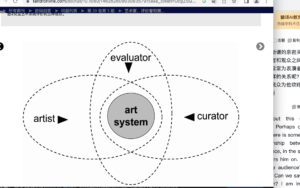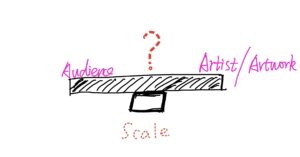For this week’s curatorial session, it was an honor to hear from EMBASSY. This is an artist-led organization, based in Edinburgh, that aims to support early-career artists by promoting exhibitions, commissioning opportunities, events, and public-facing programming. I learned from the frontline curatorial experience during the presentation by the EMBASSY staff. It was a very valuable and rare opportunity.
What struck me was one student’s question, “Who is more important to a successful curation, the audience or the artist?” This is a difficult topic to balance. In curating, the curator is the link between the audience and the artist. But when there is a separation between the opinions of the audience and the artist, who is more important? Or, who is the audience whose needs should be prioritized by curation?
In the 1960s, the French writer André Malraux(J. P. V. ,2000), when he was the French Minister of Culture, the concept of “democratization of culture”. This contributed to a social transformation of contemporary French art and culture that is still relevant today. Contemporary art curation continues to challenge the tyranny of traditional condescending art, stimulate public participation in art, and provoke open-minded reflection. Artists, works and audiences need to present a fluid relationship of three energies, rather than a single structure. This requires curators to consider the “secondary creation” of the artwork in the conception and execution of the project. Establishing a relationship between the institution, the artwork, the artist, and the viewer. Contemporary curators have moved beyond their initial role as custodians and caretakers of objects to become more dynamic and proactive. It has become an intermediary that facilitates the connection between the artist, the artwork, and the viewer. (Ernest et al, 2009). Thus, as a curator, the artwork has a double meaning. It is not only a medium for the artist to express his emotions, but also a bridge for the audience to receive and emotionally marry. The importance of both cannot be overstated. While communicating in both directions, emotional interchange achieves a balanced state in the art realm.

However, in other words, when there is a conflict between the artist and the audience, whose role is dominant? How to strike a balance? In my opinion, it is difficult to reach a balance. Artworks are created by people. Man is fundamentally an interdependent group animal. The relationship in society, both religious and aesthetic, is organic. The balance we are talking about is itself an ideal state. (Perricone, 1990).


Reference
1.Ernest Edmonds, Zafer Bilda & Lizzie Muller (2009) Artist, evaluator and curator: three viewpoints on interactive art, evaluation and audience experience, Digital Creativity, 20:3, 141-151, DOI: 10.1080/14626260903083579
2.Perricone, C. (1990). Artist and audience. J. Value Inquiry, 24, 199.
3.Herubel, J. P. V. (2000). Andre Malraux and the French Ministry of Cultural Affairs: a bibliographic essay.


Leave a Reply